At The Whim Of The Waves
musky paths & sea-sparkle
Oyster shell, incoming tide. Walcott beach, Norfolk. 8 July 2024.
Hello, and a warm welcome to this New Moon and Old Midsummer edition of Bracken & Wrack.
There’s a slightly hazy and unfocussed July feeling to the newsletter this time, I think. The weather has been strange; one moment damp and drizzly and the next a clear blue sky. Yesterday there were two massive thunderstorms and I watched awestruck from the cottage doorway as huge raindrops bounced off the paving. On the other hand the days are still long, there have been several early-morning-coffee-on-the-beach days and, wonderfully, some little adventures further afield in the best company.
We walked beside the mud flats of Old Felixstowe on a perfect day, 29 June 2024. Something always happens … and there’s a story for next time.
Behold the apples’ rounded worlds:
juice-green of July rain,
the black polestar of flowers, the rind
mapped with its crimson stain.
The russet, crab and cottage red
burn to the sun’s hot brass,
then drop like sweat from every branch
and bubble in the grass.
They lie as wanton as they fall,
and where they fall and break,
the stallion clamps his crunching jaws,
the starling stabs his beak.
In each plump gourd the cidery bite
of boys’ teeth tears the skin;
the waltzing wasp consumes his share,
the bent worm enters in.
I, with as easy hunger, take
entire my season’s dole;
welcome the ripe, the sweet, the sour,
the hollow and the whole.
Laurie Lee, ‘Apples’.
If you click the link below you can hear ‘Apples’ recited by Laurie Lee himself.
https://poetryarchive.org/poem/apples/
Apple ripening in the cottage garden. 8 July 2024.
A JULY TWILIGHT WALK ALONG THE LANE
There’s been light rain on and off, subduing the dust to moist earth and re-greening and freshening the jaded edges. Now, the tired verges sing again and their scent rolls out like the unwinding of a bolt of fine silk. There’s nothing overpowering about it, no dominating aroma, but an earthiness, green and still growing. A pushing forward of the young fruits-in-waiting as blackberry flowers scatter the tiniest perfect hearts on the tarmac and spangle the meadow grasses.
Motionless on the lane, then turning to look at me and melting into the bracken, a roe deer. Then the flicked-up tail of a rabbit catches my eye. These blackberries of the wild edges still have pink petals, contrasting exquisitely with the already bobbly but completely green centres. Soon the reverse will be true as green sepals frame the reddening fruits. And it looks as if those fruits will be very plentiful, or at least I hope so.
I’m revelling in the juicy voluptuousness of the bracken at its green zig-zag peak. You can almost feel the swollen fronds pushing one against another, pulsing and nudging.
Wild honeysuckle in the lane. 3 July 2024.
I’d intended to turn back at the corner, but perhaps the roe deer has climbed up to the grass and gorse, or maybe the fox cubs are playing rough and tumble in the half-light. Better not risk missing that how I’m here. So I turn towards the heath, where the wild honeysuckle is calling. I can feel its sweetness in my nostrils. Those trumpets are sounding and I revel in their shapes and colours. The gorse tips that they sit between are pale and engorged, growing, growing. Here the blackberries seem further advanced: fewer petals, redder incipient berries. Masses and masses. A sight to behold.
Onto the heath, and the path smells of woodlands. Exciting, musky, damp. No deer but oh, the colours. Since my last visit the heath has exploded in beauty. I can hardly take in all the shades and textures. Purples, pale milky creams, darkest purple heather, tiny starry white flowers crouched underneath everything. Slender stems. Fluffy, airy purple grasses, and others so fine they’re as smooth as a rat’s tail. The nettles’ dangling seed-strands are dark purple too. Wild carrot umbels, gorgeously pink, float between the spires. I forget to breathe. I want to capture it all, every vista, every millimetre. Now here is magic, an unlooked for magic which may just be one of the best kinds there is.
Wild carrot flower on the heath. 3 July 2024.
THE BLACKBERRY PICKER (part 1)
While we’re talking blackberries, I remember an essay I wrote a year or two ago on that very topic. The Blackberry Picker has never been published, so I’m thinking that Bracken & Wrack might be just the place for it. Especially if I begin serialising the story in this edition so that it can unfold over the next few weeks in tandem with the ripening berries. The references to the seasons of previous years are out of date now, so I hope that won’t be confusing. But otherwise I really hope you’ll enjoy it and find it evocative of July-into-August days on a quiet lane in north Norfolk.
Bramble bushes, 3 July 2024.
Part I:
The car draws level with me on the lane. I’m tucked up on the verge, picking. Few cars use the lane, so I’m comfortable with harvesting fruit from its margins. Not too low down, of course. That’s different. There may not be many cars but there are plenty of dog walkers.
I pick every morning before I write. It feels as if something important is missing if I don’t, and not just the satisfaction of adding to the growing stash of freezer bags replete with their glittering jewel-haul. Glittering, because once the berries are washed I open-freeze them, tipping the tray this way and that so that they nudge and settle. A few hours later I tap the frosted berries free and tip them rattling into the bags, ready to be coaxed into corners of my modestly-sized freezer. Jam is the next thing I think, when freezer space well and truly runs out.
It’s very quiet. Sometimes I hear the sudden guffaw of a green woodpecker, or the repeated hollow bark of a muntjac deer. Often, now, a family of swallows perches above me as I pass the turn to Old Lane. Squinting up at the telegraph wire, a slim crack against the already-blue sky, I count their silhouettes. Six. As always, I rejoice in the length of their tail streamers. I see more martins than swallows here, but the swallow family has been coming back to my neighbours’ barn each year since my arrival. And who knows for how long before that?
Often I have to carefully set down my favourite pottery colander to disentangle a liberty-taking bramble cane. Pulling away is no good at all, I know. Its grip would only become more stubborn, its hooks more insistent on pulling a thread or worse still, ripping my thin summer dress.
Every approaching vehicle is audible from a great distance, so peaceful is this lane. I always find myself, illogically, hoping that the driver will pass by the end without turning down here. It’s almost as if I have to keep the activity secret; that if other people realise the pickings are so rich I will go out one morning and find the bushes bare. Clearly this is ridiculous and unworthy. For one thing, weirdly, it seems that I am the only one who ever gathers these show-stopping blackberries. But maybe, just maybe, it’s an inbuilt response. Could it linger from a time when the hedgerow harvest made all the difference in the world to the poor who were always within a hair’s breadth of being forced into the workhouse? And before that, to medieval peasants in times of plague and famine? But cast back much, much further, and imagine a time before hedgerows, when the edible treasure of wild fruiting trees and bushes really did hold the balance between starvation and survival for our prehistoric ancestors.
Blackberries in the pottery colander made by David the Potter who throws my candle vessels.
In one hand I grip the half-filled colander. The other stretches deftly between nettle stem and thorn to test each berry between thumb and forefinger. I hardly have to touch them. It’s an art gained over many decades, so well tuned now that I can’t remember a time when I couldn’t judge the crucial difference between the silent snap of a berry leaving its hull willingly, one that falls too readily into my hand or, strangely, being reluctant to part from the bush yet squidging unpleasantly when a little pressure is applied. But things rarely reach that stage as I will already have noted the visual clues that commend each perfect blackberry to my bowl.
This morning, the sound grows louder and I know that the car will soon pass me as I press myself into the side and that I will raise a hand in acknowledgement of their slowing down. It’s a narrow lane. As I turn around, I hear a window being lowered. A woman leans out; a well-dressed countrywoman, perhaps early retired. She looks surprised to see me picking.
‘Are they ready already? It’s August!’
‘Oh, they are, yeh. Actually, some of them are going over already.’
‘I imagined they’d be all dried up with this drought’.
‘No, they’re good. The best I’ve known for years; since I’ve been here’ - gesturing up the lane towards The Old Shop.
‘Oh, well. I shall have to take a look. I’m in East Ruston and there are a lot of lanes there.’
She’s not wrong. I’ve read that East Ruston is the Norfolk parish with the most miles of lane; around 20 in all. The number of times I’ve found myself completely lost there, I can well believe it.
‘Anyway, I’m off to the beach for the day with the little one’, she continues. ‘It’s too hot for her on the heath.’
I’d first assumed a child, but she seems a little old for that. A grandchild? Oh of course; a dog! Sure enough I glimpse a small furry face in the passenger seat.
‘Have fun!’.
‘We will!’ and she’s off, leaving me wondering whether she will actually get around to picking in the lanes of East Ruston and whether you ever got lost if you lived there.
To be continued next time …..
THE SNAIL & THE SEA (& COFFEE)
High tide
I watch a snail crawl across the promenade
pulled perhaps by the scent of brine
and the gentle crash of waves
antennae outstretched, making a snail-line for the sea.
What are you thinking, snail
as you mark your path with silvery dots?
What when you reach the edge?
I will never know. I walk on, the thought of coffee
burning a hole in my curiosity.
A thin strip of golden-granulated sand
a scatter of pebbles
iced with a flourish of creamy foam.
At the whim of the waves I hop
from concrete scallop to sand
I’m heading east.
Sea sparkle sun glare
gulls glide lazily white against blue
waves roll over smooth and brown below
like the chocolate covering on a mini swiss roll
(beloved of childhood Sunday teatimes)
only inside out. I think of the cacao smoothie
waiting in the fridge for breakfast.
So I spread my woven mat
take out the coffee things
(well-practised you can tell)
twist open the flask
pour steaming water over ground beans
tear open the cereal bar
apple, raisin and cinnamon. I can smell the cinnamon.
That moment when I pour.
Coffee scent, sea scent, steam, shhh of the wavelets
sliding in. I see a washed up piece of tree
splintered, beached
its journey broken by the sloping planks
hewn and fashioned and strongly bolted.
I think it’s a cliff top sycamore
one by one they’ve slipped over the edge
cast to the mercy of the waves
but the beautiful waves do not know how to be merciful.
Do we think we can tame the sea
with our stout planks and chunks of metal?
The tree calls I am made of the same stuff
and no we can’t tame the sea.
The tide will bring what it brings
and we are just awestruck bystanders.
Let’s accept that and glory in being here
witnessing raw power, strength and beauty
not to mention the way that each wavelet
caresses the smooth shoreline
conferring its delicious fingerprints
while the sand shivers in ecstasy.
The sea will show its colours whatever we do.
Sometimes a wave will surprise and tease
streaming beneath my perch
playing and weaving
leaving strings of lace-edged bunting
traced on the sand.
As for my regretted footprints
all it takes is one outstretched wave
to wipe the slate clean.
Wood against wood: tree and sea defence at Walcott/Happisburgh, Norfolk.
THE MIRACULOUS PAINTED LADY
In a wild garden that’s always buzzed and fluttered with bees and butterflies it’s sadly noticeable, not to mention uncanny, when all that action suddenly ceases. But - apparently because of this year’s aforementioned strange weather patterns - things here are weirdly quiet. Usually in July I would constantly be thrilled by colourful flickering wings as red admirals, peacock butterflies and painted ladies moved joyously from flower to flower. Although I now know that it’s something that’s being experienced everywhere and not just in this little corner of Norfolk, and although I’m confident that nature will redress the balance over time, I do really miss watching my wild guests and can’t help feeling worried that some of the species may find it harder than others to recover.
An event that has really brought home the difference in the garden this year has been the opening of the hemp agrimony flowers in the front yard. I had told myself that this was the moment that would call in every butterfly within a five mile radius and all would then be well, so ecstatically greeted were these flowers last year and the one before. Well, you’ve guessed it, the tightly furled buds have begun opening to pink over the past couple of days without a single butterfly being drawn magnetically to the feast, let alone the dozens of revellers who usually roll up.
Hemp agrimony in front of the outbuilding, but no butterflies yet. 8 July 2024.
It’s a little wistfully, therefore, that my mum’s soft, thin and much-laundered 1960s linen tea towel depicting butterflies of the British Isles gets wrapped around our big cafetiere when heading out on an adventure. Here it is on the washing line after its latest outing. The painted lady (centre right) caught my eye as I have just been reading about the incredible life cycle of this wanderer of the ways.
My mum’s 1960s butterfly tea towel, thin but still beautiful, used all the time as a wrapping cloth.
In a normal year - and perhaps soon, fingers crossed - clouds of painted lady butterflies would now be flying in on the summer breezes. Actually, rather than arriving at their destination they are merely passing through, as their life cycle requires them to be perpetual nomads.
As Lia Leendertz explains in the Almanac for 2020, this delicate butterfly with its orange and brown patterned paper-thin wings has a monumental migration. The population we see here in the UK travels each year from tropical Africa to the Arctic and back again, the longest migration of any butterfly. But no single individual will complete the whole journey. It takes up to six successive generations to make the entire 12,000 km round trip, guided by an innate drive and the position of the sun. No parent has ever taught a painted lady the route.
It was once thought that the butterflies died when they reached the north, but we now know that the return journey south is made at such an altitude that no-one has ever seen them travel.
The painted lady breeds all year round, and searches endlessly for the perfect breeding conditions. It continually changes its surroundings rather than adapting its own breeding behaviour in any way to fit with the seasons, so it chases summer up and down the northern hemisphere, hitching a ride on favourable winds, and trying its luck in every varying climate.
Conditions here at this time of year are usually perfect for its requirements. Warmth but not too much, plenty of rain and lush growth. The male perches somewhere until a female passes by, when a courtship dance plays out. The pair mate back to back and then the female lays her eggs, usually on a thistle or aster, before moving on to try again elsewhere. The eggs hatch into caterpillars which fatten up on greenery, pupate, and then pick up the baton for their own leg of this endless migration.
Painted lady on a thistle. I had forgotten how magical butterfly eggs and pupae are too, when you look closely.
Next time, as well as part 2 of The Blackberry Picker there’ll be a story about mud, a recipe for St Margaret’s Day, a crafting session and a dark tale of Thetford Priory (above), whose extensive and enigmatic ruins we visited a few days ago.
Until then.
With love, Imogen x




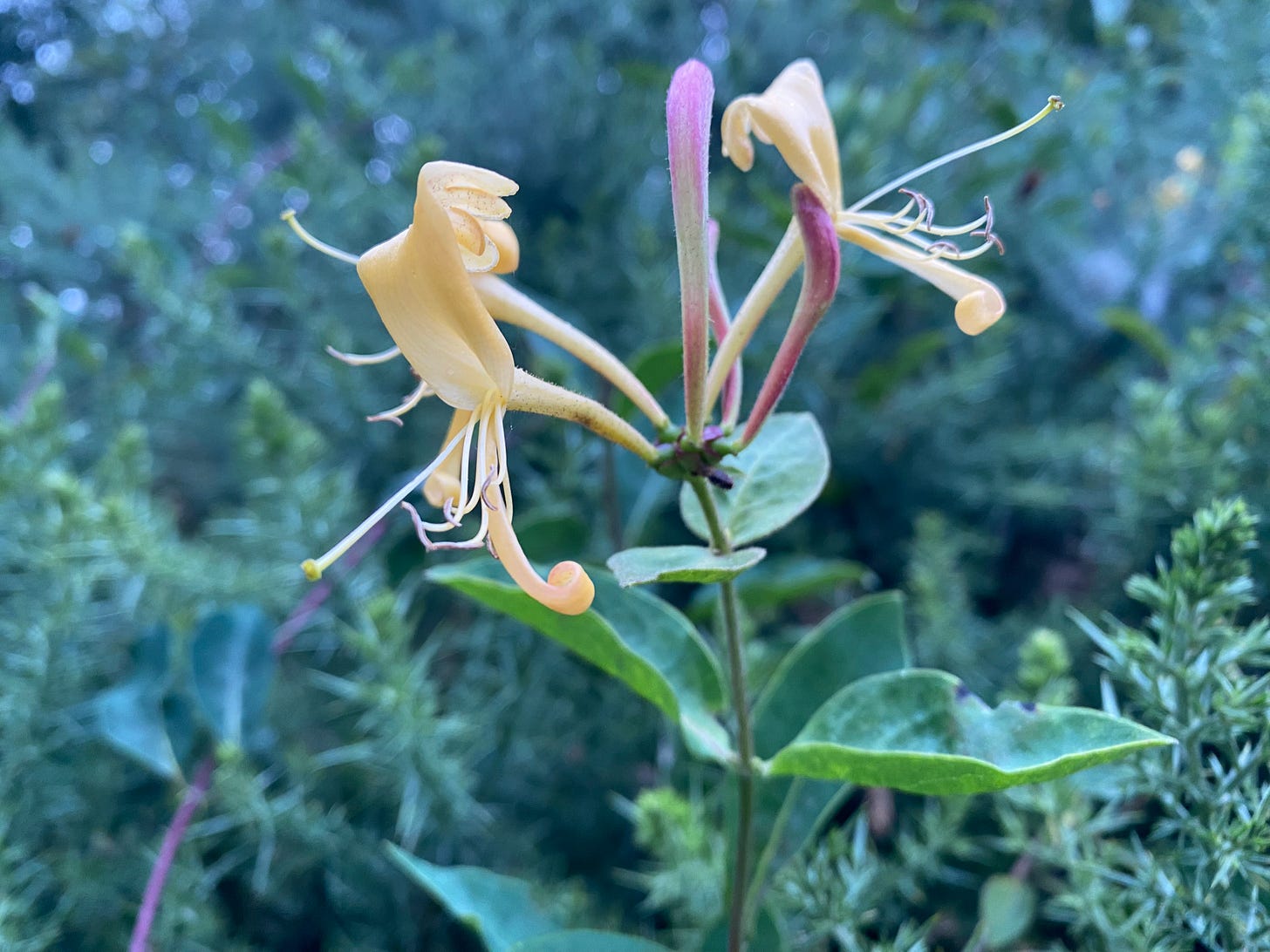
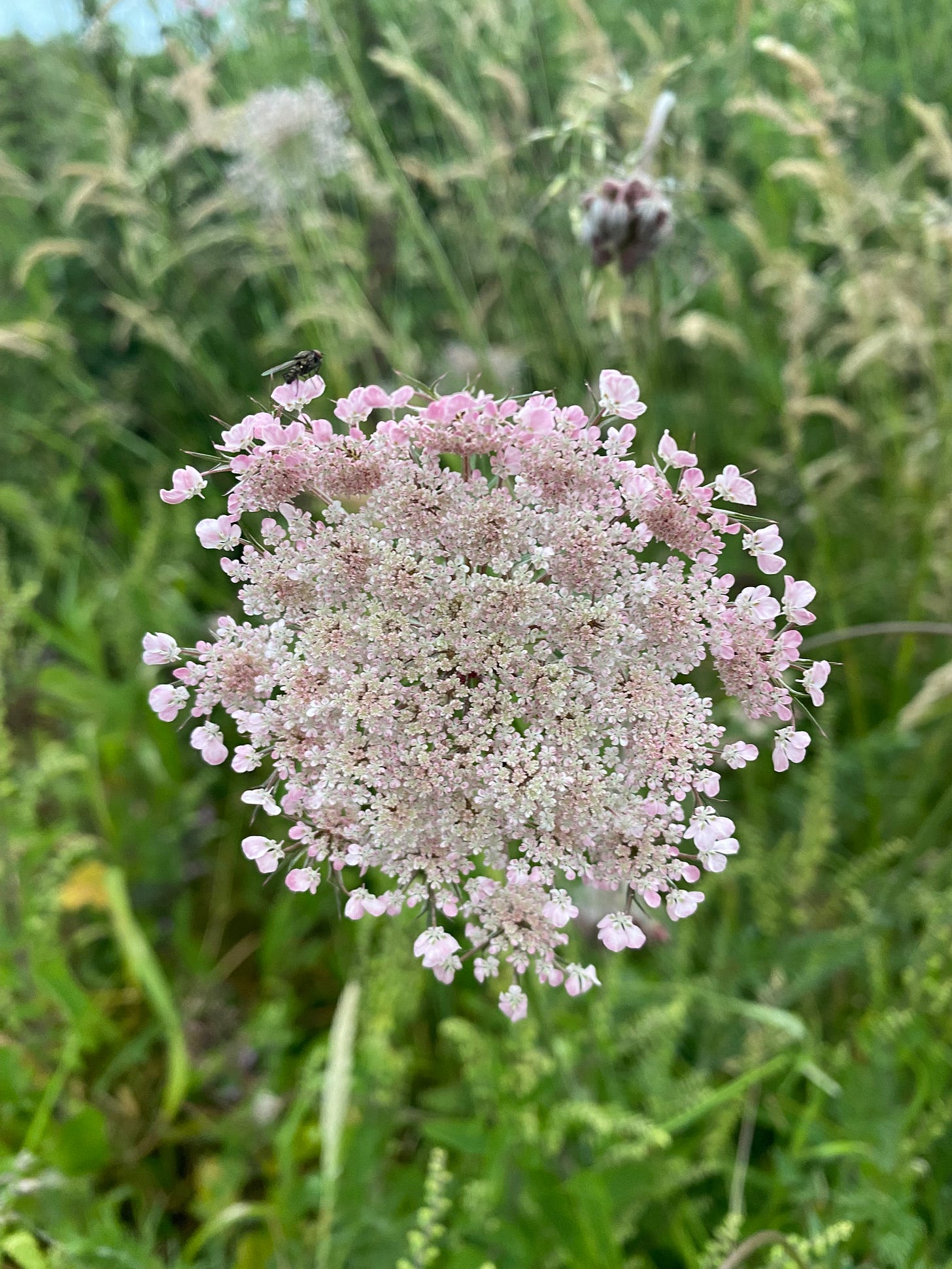

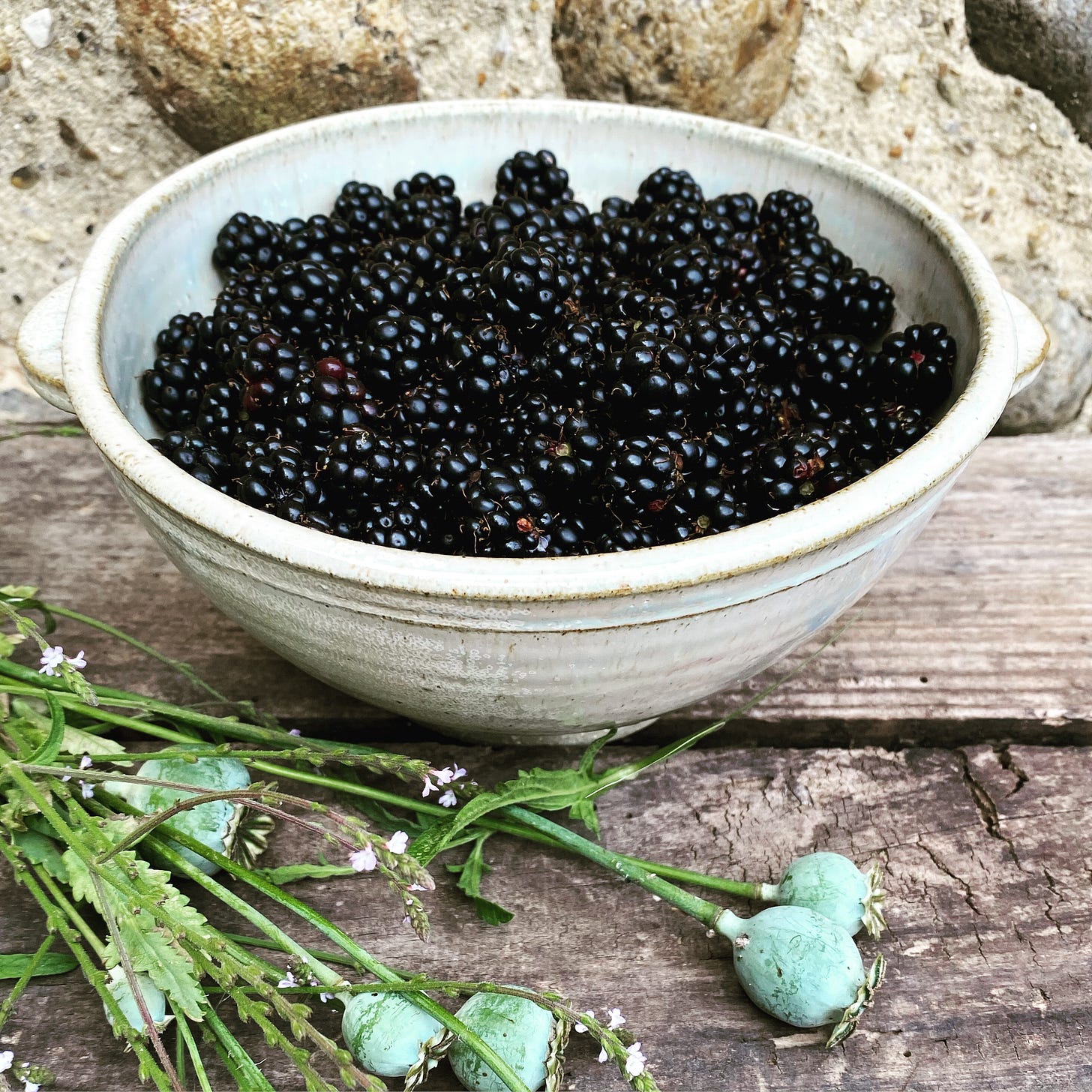


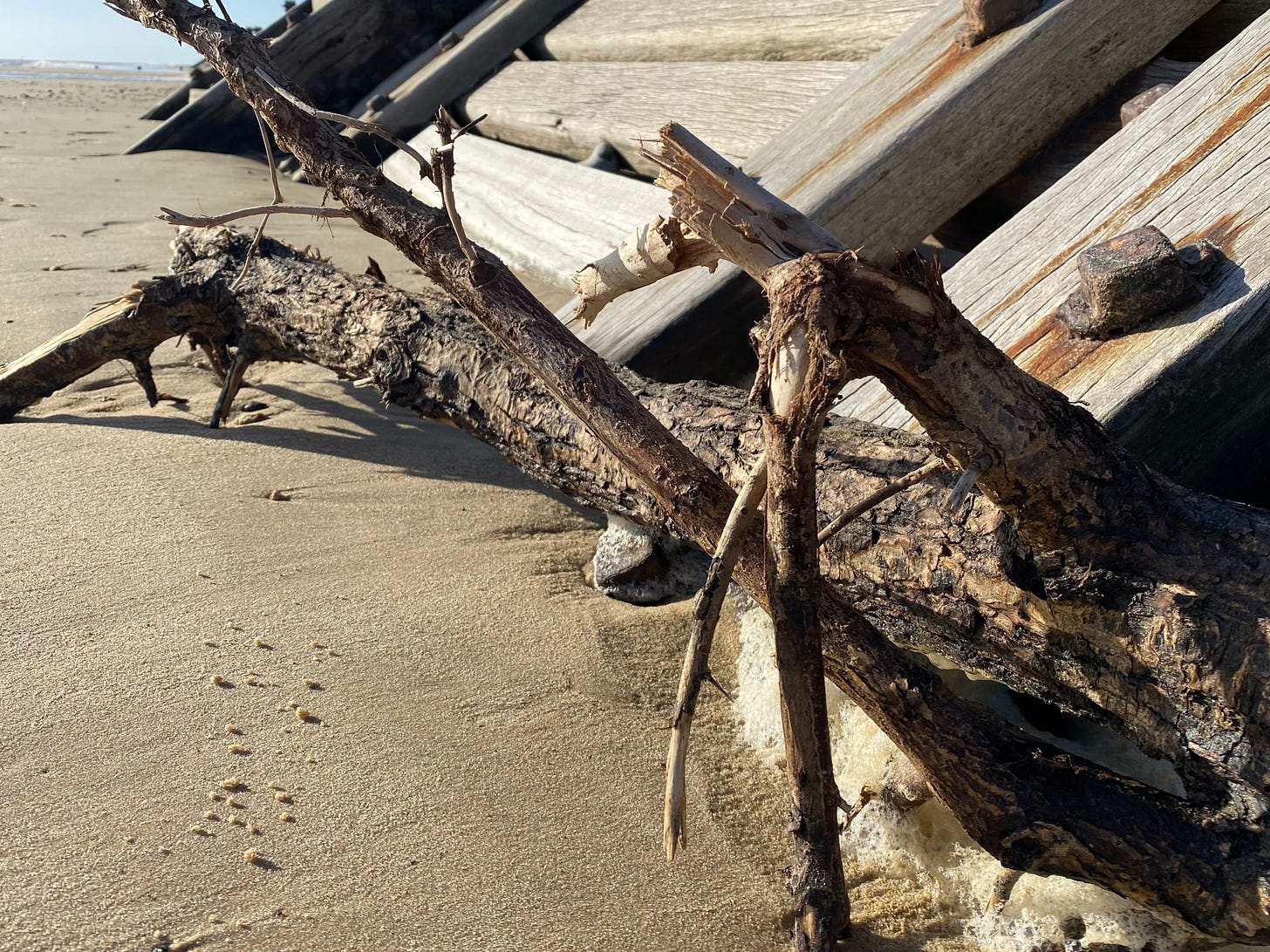

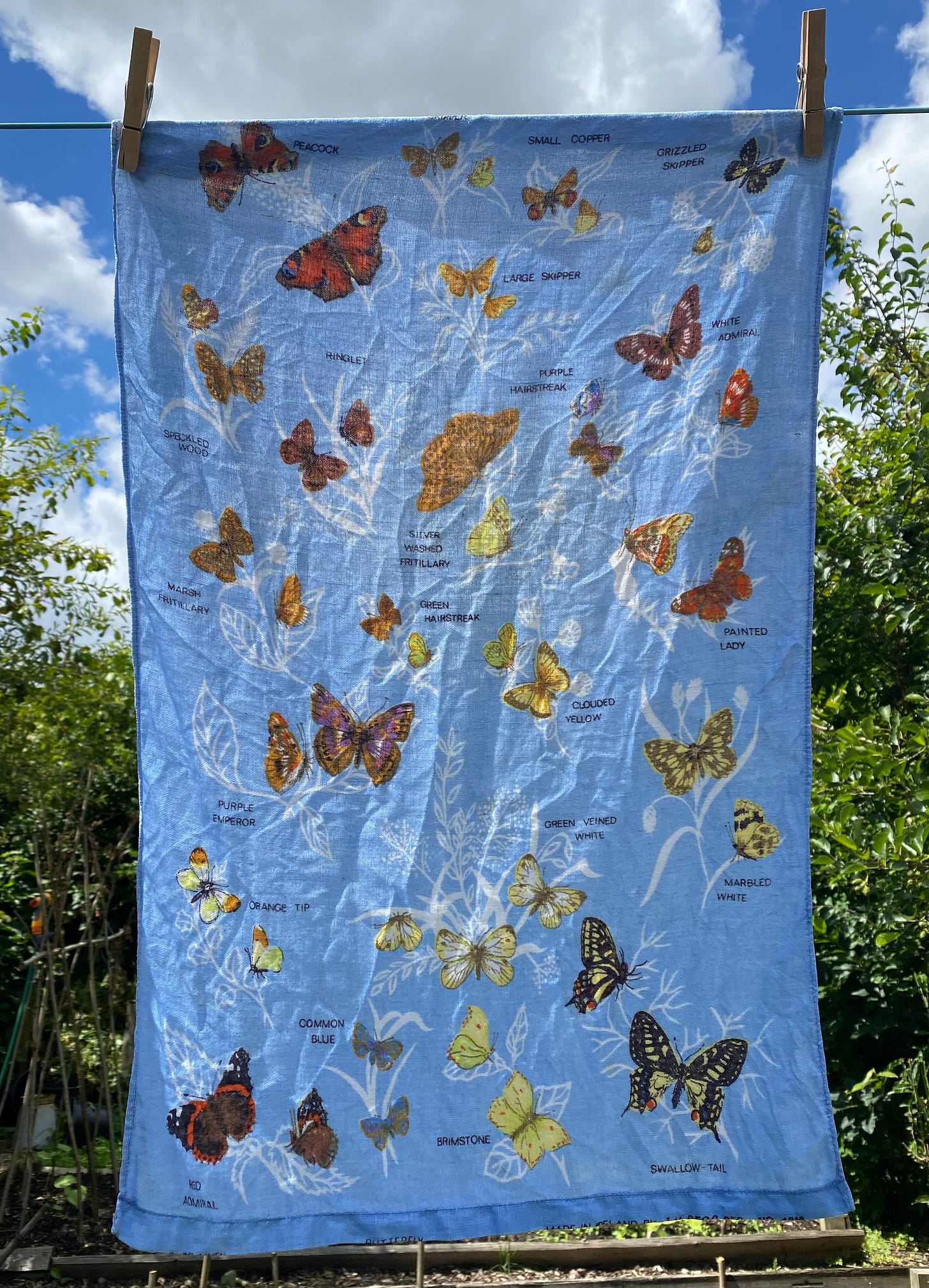

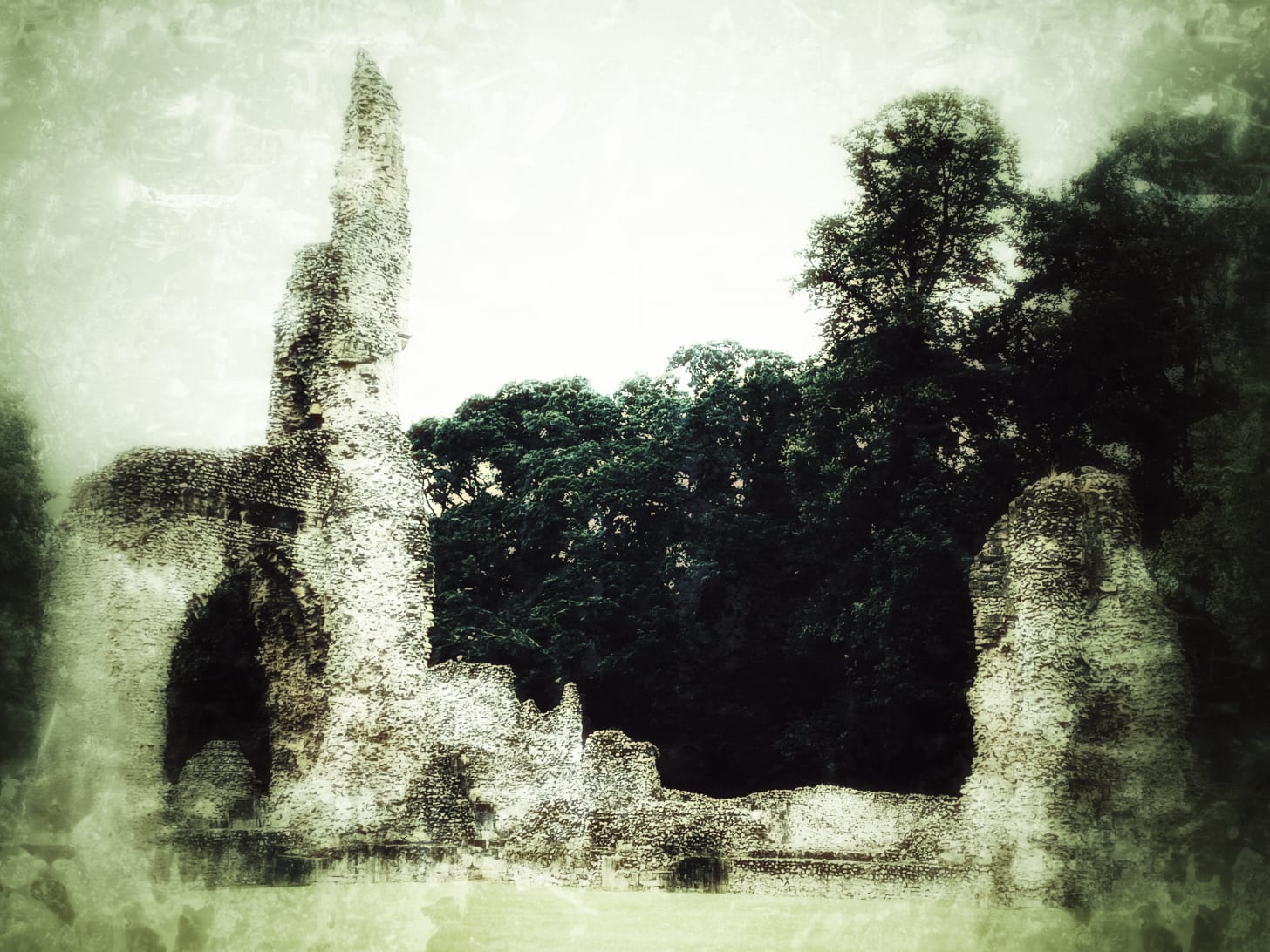
Ahhh this was a lovely early morning read, Imogen. I loved the first part of the blackberry story. It took me right back to when I lived in a block of flats in North London with a gorgeous communal garden that provided me with many, many blackberries. I am an early riser and would go down from my fourth floor flat and gather them when it was oh so quiet… never saw anyone else picking them - all mine!
I have seen one or two painted ladies this year,in the wonderful meadows that surround my home. Thank you for this delicious post on a cold, damp and dark evening here in Somerset, it provided a sunny warmth for my evening.